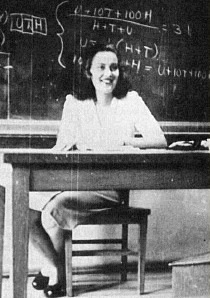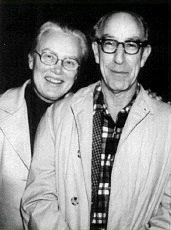born: Dec 7, 1924 in Hillsboro, Texas
An authority on set-theoretic topology with more than 70 published research papers and a book. Skilled at constructing counterexamples. A product of the “Moore Method.”
It is possible for a woman from rural southwest Texas (“many kids came to school on horseback”) to earn a Ph.D. in mathematics, do first-rate mathematics, supervise 11 Ph.D. students, raise a family of 4 children, and be a genuinely nice individual. Mary Ellen Rudin is the “proof by example.” Sometimes mathematical talent shows up very early, but often it is in “a perfectly normal average kid ” who doesn’t bloom until later.
Mary Ellen Estill grew up in Leakey, Texas. “We had few toys. There was no movie house in town. We listened to the radio. But our games were very elaborate and purely in the imagination. I think actually that that is something that contributes to making a mathematician — having time to think and being in the habit of imagining all sorts of complicated things.” She did well in school and enjoyed it as much for her friends as for the education. She went to college in 1941 expecting to get C’s, but “made A’s without any trouble.”
When she registered at the University of Texas the room was packed, but “there were few people at the mathematics table so I was sent over there. The man who was sitting there was an old white-haired gentleman. He and I discussed all kinds of things for a long time. When I went to my math class the next day, I found the professor was R.L. Moore — the same man who talked to me at the registration table.” Moore had decided at the registration table that Rudin had mathematical talent, and he arranged to teach every math course she took until her senior year.
Moore’s method of teaching did not use textbooks or lectures. He began courses by filling the blackboard with definitions and statements. The students spent the rest of the term trying to prove the true ones, find counterexamples to the false one, and figure out which were which. In class each day, the students would report their progress. If no one had any progress to report, then “we would start discussing something — it could be politics or anything.” There were no tests.
Rudin found the whole University fascinating and exciting. She took mathematics courses, but “it was just one of many things I was taking.” As a senior she went to the guidance office and asked what she should specialize in. After some tests, they suggested mathematics. A week later she was offered an instructorship and stayed at the University of Texas to do graduate work in mathematics. More Moore. “I’m a child of Moore. I was always conscious of being maneuvered by him. I hated being maneuvered. But part of his technique of teaching was to build your ability to withstand pressure from outside. So he maneuvered you in order to build your confidence. He built your confidence that you could do anything. I have that total confidence to this day.” Rudin got her Ph.D. in 1949 and took a teaching job at Duke University. Her feelings about Moore are mixed, and she never uses his method with her students. “I’m a perfectly straightforward, enthusiastic lecturer. I bubble, and I get students enthusiastic. I’m able to explain things.”
At Duke she met Walter Rudin, and they were married in 1953 after he got his Ph.D. in mathematics. They moved to the University of Rochester where Walter had a job, and she was given a course to teach. “I was a temporary part-time something.” The status and pay were terrible, but the job itself was pleasant. “I was a mathematician, and I always thought of myself as a mathematician. I always had all the goodies that go with being a mathematician. I had graduate students, I had seminars, I had colleagues who loved me. I never had committees. I did lots of mathematics, but I did it because I wanted to do it and enjoyed doing it, not because it would further my career.” In 1959 the Rudins moved to the University of Wisconsin where Mary Ellen again had a part-time position as a lecturer, the lowest rung on the academic ladder. In 1971, after numerous publications and even an international award for her research, she was promoted, all the way from lecturer to full professor, the top rung on the ladder. “The guilt feelings in the math department were such that nobody even asked me if I wanted to be a professor. I was simply presented with this full professorship.”
Rudin has been active in several mathematical organizations, and was vice-president of the American Mathematical Society. She also has four children. “I have never minded doing mathematics lying on the sofa in the middle of the living room with children climbing all over me. I like that situation. I feel more comfortable and confident when I’m in the middle of things, and to do mathematics you have to feel comfortable and confident.” One daughter is a linguist, one is an engineer, and one son is studying to be an M.D. “Our retarded son is a janitor. Walter says he’s our greatest success. He’s living way beyond his intelligence while the others are just living up to theirs.”
How does she do mathematics? “I draw little pictures and try this thing and that thing. I’m interested in how ideas fit together. Actually I’m very geometric in my thinking. I’m not really interested in numbers.” And how does mathematical talent show itself? “It’s in pattern recognition.”
Mary Ellen Rudin may have been a normal average kid, but we can all recognize the pattern of a special talented adult.
Condensed by Dale Hoffman from “An Interview With Mary Ellen Rudin” by Donald J. Albers and Constance Reid in the College Mathematics Journal, March, 1988.
Last Updated September 22, 2022


